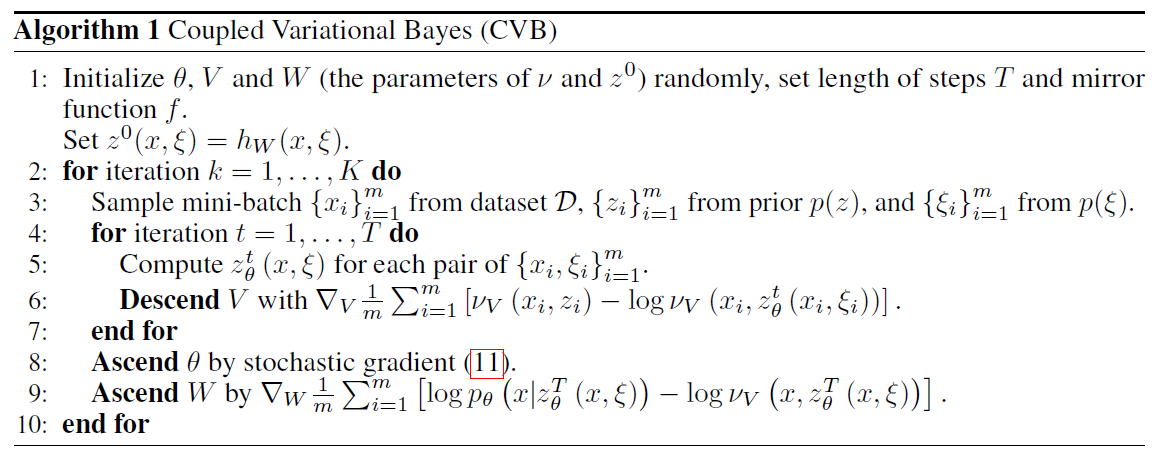Coupled Variational Bayes via Optimization Embedding (NeurIPS 2018)
Abstract
VI’s success depends on two things!
- Good Approximation
- Computation Efficiency
Proposes Coupled Variational Bayes, which exploits primal-dual view of ELBO, with variational distribution class generated by optimization embedding
- this flexible function class “couples the variational distribution with original parameters”
- allows end-to-end learning
1. Introduction
Probabilistic models with Bayesian Inference….for
- 1) modeling data with “complex structure”
- 2) “capturing uncertainty”
Choosing proper variational distn is important
- ex) MFVI : reduce computation complexity, but too restricted
- ex) Mixture models & non-parametric family : generalization
- by introducing more components : more flexible
- but computational costs increases
- ex) Neural Networks parameterized distributions
- ex) Tractable Flow
using NN for computation tractability restricts expressive ability of the approximation
Not only (1), (2) but also (3) is important!
- (1) approximation error
- (2) computational tractability
- (3) SAMPLE EFFICIENCY
Provides Coupled Variational Bayes (CVB)….2 key components :
- 1) primal-dual view of ELBO
- avoids computation of determinant of Jacobian ( in flow based model )
- 2) optimization embedding
- generates an interesting class of variational distn
2. Background
2-1. Variational Inference
ELBO :
- \(\log p_{\theta}(x)=\log \int p_{\theta}(x, z) d z \geqslant \mathbb{E}_{z \sim q_{\phi}(z \mid x)}\left[\log p_{\theta}(x, z)-\log q_{\phi}(z \mid x)\right]\).
Solving above :
- 1) appropriate parameterization for introduced variational distns
- 2) efficient algorithms for updating the params \(\{ \theta, \phi \}\)
- using SGD
2-2. Reparameterized Density
Recognition model ( Inference Network ) to parameterize variational distribution!
widely used : \(q_{\phi}(z \mid x):=\mathcal{N}\left(z \mid \mu_{\phi_{1}}(x), \operatorname{diag}\left(\sigma_{\phi_{2}}^{2}(x)\right)\right)\)
-
where \(\mu_{\phi_{1}}(x)\) and \(\sigma_{\phi_{2}}(x)\) are NN
-
such reparams have closed-form of entropy
\(\rightarrow\) gradient computation & optimization is relatively easy
2-3. Tractable flows-based model
Assume a series of INVERTIBLE transformations as \(\left\{\mathcal{T}_{t}: \mathbb{R}^{r} \rightarrow \mathbb{R}^{r}\right\}_{t=1}^{T}\)
-
\(z^{0} \sim q_{0}(z \mid x)\).
\(z^{T}=\mathcal{T}_{T} \circ \mathcal{T}_{T-1} \circ \ldots \circ \mathcal{T}_{1}\left(z^{0}\right)\).
-
\(q_{T}(z \mid x)=q_{0}(z \mid x) \prod_{t=1}^{T}\mid \operatorname{det} \frac{\partial \mathcal{T}_{t}}{\partial z^{t}}\mid^{-1}\).
However, general parameterization of the transformation may violate…
- 1) invertible requirement
- 2) expensive / infeasible calculation for the Jacobian & determinant
3. Coupled Variational Bayes
(1) consider VI from primal-dual view
- avoid computation of determinant of Jacobian
(2) propose the optimization embedding
- generates the variational distribution
- “automatically” produces a non-parametric distribution class ( very flexible )
3-1. A Primal-Dual View of ELBO in Functional Space
Flow based model
-
pros) introduce more flexilibity
-
cons) calculating determinant of Jacobian introduces extra computational costs
\(\rightarrow\) with “primal-dual view” , AVOID SUCH COMPUTATION!
ELBO (1) :
\(L(\theta):=\mathbb{E}_{x \sim \mathcal{D}}\left[\log \int p_{\theta}(x, z) d z\right]=\max _{q(z \mid x) \in \mathcal{P}} \underbrace{\mathbb{E}_{x \sim \mathcal{D}} \mathbb{E}_{z \sim q(z \mid x)}\left[\log p_{\theta}(x \mid z)-K L(q(z \mid x) \mid \mid p(z))\right]}_{\ell_{\theta}(q)}\).
-
\(p_{\theta}(x, z)=p_{\theta}(x \mid z) p(z)\).
-
\(\mathbb{E}_{x \sim \mathcal{D}}[\cdot]\) denotes the expectation over empirical distribution on observations
-
\(\ell_{\theta}(q)\) = objective for the variational distrn in density space \(\mathcal{P}\) under the probabilistic model with \(\theta\)
ELBO (2) :
\(L(\theta)=\mathbb{E}_{x \sim \mathcal{D}} \mathbb{E}_{z \sim q_{\hat{\theta}}^{*}(z \mid x)}\left[\log p_{\theta}(x, z)-\log q_{\theta}^{*}(z \mid x)\right]\).
- denote \(q_{\theta}^{*}(z \mid x):=\operatorname{argmax}_{q(z \mid x) \in \mathcal{P}} \ell_{\theta}(q)=\frac{p_{\theta}(x, z)}{\int p_{\theta}(x, z) d z}\)
- can be updated by SGD

- derived, based on Fenchel-duality and interchangeability principle
With primal-dual view of ELBO…
- able to represent distribution operation on \(q\), by “local variables \(z_{x,\xi}\)”
- provides an implicit nonparametric transformation \((x, \xi) \in \mathbb{R}^{d} \times \Xi\) to \(z_{x, \xi} \in \mathbb{R}^{p}\)
- with the help of dual function \(\nu(x, z)\), can avoid computation of Jacobian
3-2. Optimization Embedding
construct special variational distn, which integrates \(q\)
( i.e transformation on local variables & original parameters of graphical models \(\theta\) )
CANNOT UNDERSTAND….

